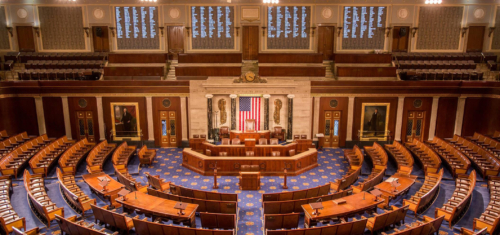Establish the U.S. Business-Education Workforce Dialogue
The President should direct the Department of Commerce and the Department of Education to immediately co-establish the U.S. Business-Education Workforce Dialogue – a framework of ongoing discussion and collaboration between business and education leaders to regularly examine kindergarten through grade 12, community college, and university curricula to ensure that the nation’s education system serves the broader educational needs of American students, as well as the skill requirements of 21st century businesses.
The Dialogue should include educators at K-12 schools, community and vocational colleges, and universities, as well as leaders of multinational corporations, regionally active firms, small businesses, and young startups. Dialogue participants should meet on a regular basis – at least semi-annually – in pursuit of a robust and specific agenda, facilitated by a dedicated staff.
Importantly, the Departments should neither set the agenda for the Dialogue nor seek to pre-determine its outcomes. Rather, the Administration’s role should be to establish, facilitate, and encourage the Dialogue, allowing business and education leaders to identify the relevant issues and, working together, develop and implement effective solutions, with the help of policymakers.
A particular focus of the Dialogue should be to better leverage the value of the nation’s 1,200 community colleges. Whether serving as an educational “on-ramp” for first generation college-goers or low-wage/low-skill adults, offering cutting-edge occupational training, or working with businesses to provide continuing education and training for their employees, community colleges are the natural backbone of the nation’s workforce development efforts.
At its best, the Dialogue should seek to make employers fully integrated partners with American schools, colleges, and universities in producing both a highly educated and appropriately trained, “ready-on-day-one” workforce. Employers should not only communicate their skill needs to educators, but also provide business community input into curricula determinations, help set aptitude standards, develop apprenticeship programs and work/study arrangements, and encourage active business professionals and other practitioners to serve as teachers, instructors, assistants, advisers, and mentors.
This kind of active collaboration would likely produce substantial savings for businesses – U.S. employers spend about $415 billion each year on informal on-the-job training and an additional $175 billion each year on formal education and training, according to Georgetown University’s Center on Education and the Workforce.
A regular and robust dialogue between U.S. business and education leaders offers tremendous and highly tangible potential benefits to the nation and its citizens. Economists at Harvard University have estimated that if the math proficiency of U.S. students were raised to levels currently observed in Canada and South Korea, U.S. economic output could be expanded by “nothing less than 75 trillion” over the next 80 years – roughly $1 trillion annually.
Free Would-be Entrepreneurs from Obstructive Student Debt
Student loan debt, a serious and worsening problem for years, has now reached levels that threaten America’s economic future. According to the Federal Reserve, total outstanding student loan debt reached $1.56 trillion as of Sep. 30, 2017, more than tripling from $480 billion in 2006. America’s college class of 2017 graduated with an average debt of $39,400, up 6 percent from the previous year. In total, some 44 million Americans — one in four adults — are paying off student loans.
Mounting student debt poses serious challenges to the U.S. economy. A particularly dangerous anti-growth effect of record student debt is its depressive impact on entrepreneurship. Recent research has demonstrated that new businesses, or “startups,” are disproportionately responsible for the innovations that drive economic growth and account for virtually all net new job creation.
But starting a business is risky – nearly half of all startups fail within five years. Launching a new business while carrying a mountain of student debt can be virtually impossible. An analysis released last May found that “student debt is negatively related to the propensity to start a firm, particularly larger and more successful ventures.”
Indeed, millennial entrepreneurship is in free fall. The share of Americans under 30 who own a business has plunged 65 percent since the 1980s and is now at a 25-year low. According to a 2016 Small Business Administration report, millennials are the least entrepreneurial generation in recent history. Such circumstances amount to nothing less than a national emergency, which requires a commensurately serious policy response.
With this reality in mind, we propose that Congress pass new legislation that we’ve tentatively entitled the Entrepreneurs Shared Earnings and Opportunity Act (ESEOA). The legislation would be modeled on the Public Service Loan Forgiveness (PSLF) program, which was created by the College Cost Reduction and Access Act of 2007 (CCRAA). Under the terms of PSLF, former students who are full-time employees at a federal, state or local government agency, or a 501(c)(3)-designated organization, and who have made 120 on-time minimum student loan payments, are eligible to have their remaining student debt forgiven.
ESEOA would have four principal elements:
First, entrepreneurs launching new businesses and those choosing to work for a startup would be permitted to consolidate all existing student loans, both federal and private, into a single fixed-rate loan under the terms of the Federal Loan Consolidation Program, created in 1986.
Second, to provide immediate debt relief, minimum payments in service of the newly consolidated debt would be capped at $200 per month, or $2,400 annually. To provide further relief, annual payments on the consolidated student loan would be deductible from taxable income, an approach the state of Maine has recently implemented.
Third, if the entrepreneur or startup employee remains at a startup for five years (either a single firm or multiple new businesses) and has made loan payments of at least $200 on time for 60 months (five years) — for a total of $12,000 — any remaining student debt would be forgiven.
To ensure that such a program is also in the interest of the taxpayer, we envision one final element of ESEOA. We propose that entrepreneurs who participate in the ESEOA program for five years and have their remaining student debt forgiven and whose total compensation – salary plus the market value of any equity awarded – exceeds $250,000 at any time during the subsequent 10 years, pay the U.S. Treasury a small percentage – perhaps 1 percent – of their total annual compensation.
Under the terms of ESEOA, in other words, the U.S. taxpayer would, in effect, swap the forgiven debt for a stake in the entrepreneur’s potential subsequent success, with the possibility of a major pay-off. For example, if a successful entrepreneur’s total earnings over the 10-year period following debt forgiveness were $5 million, a 1-percent assessment would generate a taxpayer bonus of $50,000 – far greater in most cases than the amount of debt forgiven.
Though not without administrative challenges – such as defining qualifying “entrepreneurs” and “startups” – ESEOA is a potential solution to the obstructive impact of student debt on entrepreneurship. Freed from the burden of servicing student debt, many would-be entrepreneurs will take the risk of launching perhaps the next Microsoft, Google or Tesla. And the tax receipts generated by the additional economic activity and job creation driven by those new businesses, combined with potential bonus payments made by successful entrepreneurs, make the Entrepreneurs Shared Earnings and Opportunity Act a winner for the U.S. taxpayer.

Create a Startup Visa
Foreign-born entrepreneurs have been an important part of America’s economic landscape for many decades. A study released by CAE in December of 2017 found that 43 percent of Fortune 500 companies – and 57 percent of the top 35 companies – were founded by immigrants or a child of immigrants. These companies are headquartered in 68 metro areas across 33 states and employ millions of Americans.
And yet the United States is one of only a few industrialized nations that do not have a visa category for foreign-born entrepreneurs. In recent years, many other nations including China, Canada, Germany, France, New Zealand, Australia, Chile, and the UK – have overhauled their immigration laws to attract foreign-born entrepreneurs, including American entrepreneurs.
It should also be pointed out that many of the well-documented abuses of the existing H-1B visa process are attributable to the current lack of a clearly defined and lawful pathway for foreign-born entrepreneurs who want to build their new companies in America. Problems associated with the H-1B visa include the fact that such visas are arbitrarily capped at 85,000 per year, the demand far outstrips the supply, large companies benefit disproportionately while smaller businesses are virtually shut out, and recipients must be sponsored by a U.S. company.
With these realities in mind, CAE proposes the creation of a new visa category – a “Startup Visa” – specifically designated for foreign-born entrepreneurs who want to launch new businesses in the United States. To qualify, applicants would have to meet national security requirements and would have to have raised initial funding – perhaps $100,000 – from private investors to validate themselves as entrepreneurs and to authenticate the validity of their business idea. Under the terms of the entrepreneur visa, foreign-born entrepreneurs would be admitted on a temporary basis, say two years. If by the end of that period their business has been successfully launched, is producing verifiable revenue, and has produced jobs for at least two nonfamily members, the temporary visa would be extended – say, for an additional three years. If the new business continues to grow and has created jobs for at least five nonfamily members by the end of the initial five-year period, the foreign-born entrepreneur would be granted permanent residency in order to continue building their business and creating American jobs.
Recent research has concluded that Startup Visa would create between 500,000 and 3 million new American jobs over a decade.
Award Graduation Green Cards
A permanent residency card – “green card” – should be awarded to any foreign-born student meeting national security requirements who completes an undergraduate or postgraduate degree from an American college or university and wants to remain in the United States following graduation. Research has repeatedly demonstrated that immigrants are twice as likely as native-born Americans to start a new business. More than 1 million foreign-born students – the largest foreign-born student population in the word – study at American colleges and universities each year. Current policy requires most to leave the country after graduation, taking their U.S.-acquired education and training with them.
Establish the Entrepreneurship Corps
In 1961, President John F. Kennedy announced the establishment of the Peace Corps, a volunteer service organization through which young Americans work abroad for a period of two years with governments, schools, nonprofit and non-governmental organizations, and entrepreneurs in critical areas such as education, youth development, community health, business, information technology, agriculture, and the environment.
The Peace Corps is based on an idea originally proposed in 1950 by Walter Reuther, president of the United Auto Workers, in an article entitled, “A Proposal for a Total Peace Offensive.” Reuther argued that the United States should establish a voluntary agency for young Americans to be sent around the world to fulfill humanitarian and development objectives. “I believe that the more young Americans who are trained to be sent abroad with a slide rule, textbook, and medical kit to help people help themselves with the tools of peace, the fewer young Americans will need to be sent with guns and weapons of war.” Since its establishment, more than 235,000 Americans have served in the Peace Corps in 141 countries.
Today, the United States itself is threatened by a number of glaring social-economic challenges, including underemployment and job anxiety; stagnant middle-class wages; wide and worsening income, wealth, and opportunity inequality; persistently high rates of poverty; and, near-record numbers of Americans reliant on government programs like food stamps and disability insurance. Such problems – and the anger, cynicism, and populism they inspire – have undermined public confidence in corporations and government, led to charges that America’s political and economic system is not only unfair but “rigged,” and threatened the social cohesion and consensus that a thriving democracy requires. Building a more inclusive and accessible economy – one that “works for everyone” – has emerged as one of America’s most urgent domestic challenges. Thriving entrepreneurship is an important part of the solution.
In 1990, Teach for America (TFA) was founded by Princeton University Student Wendy Koppto address education disparities in America. TFA recruits and trains college graduates from top universities to serve as teachers for at least two years in public schools in low-income urban and rural communities throughout the United States. In September of 2015, the organization reached a milestone of 50,000 corps members and alumni, who have collectively taught more than 5 million low-income students across the nation.
Echoing President Kennedy’s historic call for volunteer service in the cause of global peace – and inspired by the more recent example of Teach for America – CAE encourages President Biden to establish an “Entrepreneurship Corps” to underscore the importance of American entrepreneurship generally and, more specifically, to promote and support entrepreneurship in distressed and underserved communities across America, with a special emphasis on assisting aspiring entrepreneurs of color.
Entrepreneurship Corps recruits should be accomplished college graduates with backgrounds in business, science, technology, engineering, and mathematics who would be assigned to one or more startups in distressed areas to assist in their development and success. The standard service commitment would be two years. Participants would earn a reasonable salary paid by the Corps and have transportation costs covered, like other federal government employees.
Like the Peace Corps, the Entrepreneurship Corps would be a prestigious national service experience for young Americans responding to Presidential call to action. And like TFA, the Entrepreneurship Corps would be an attractive post-graduation job opportunity and would deploy an army of high-quality talent with the aim of improving socio-economic conditions in distressed areas through the transformative power of entrepreneurship.
Pass the Next Generation Entrepreneurship Corps Act
Entrepreneurship is a powerful driver of economic growth, job creation, and expanded opportunity and policymakers should do more to promote and support entrepreneurship in under-served areas of the country and among under-represented aspects of the American population. With this priority in mind, CAE strongly supports enactment of the Next Generation Entrepreneurship Corps Act, introduced on February 23, 2021 by Senators Chris Coons (D-DE) and Tim Scott (R-SC), along with Representatives Jason Crow (D-CO) and Troy Balderson (R-OH). The Act will create a selection committee of 12 industry experts to review applications and select 320 entrepreneur fellows annually from diverse backgrounds to start both traditional and high-growth businesses in distressed or low-income census tracts. Selected fellows will be provided a $120,000 two-year stipend for living and basic startup expenses, healthcare coverage, interest-free deferral of federal student loans, immersive training, matching with a local business mentor, and support from an advisory board of CEOs and venture capitalists.
Pass the Primary Care Enhancement Act
Thriving entrepreneurship requires entrepreneurs not only willing but also able to launch new businesses, as well as the talented employees they need to turn new ideas into reality. Roundtables that CAE regularly conducts with entrepreneurs across the country have revealed that access to affordable, portable (not connected to a particular corporate job), high-quality healthcare is a top “mobility” priority among entrepreneurs – especially women entrepreneurs – enabling them to strike out on their own, and to attract and retain the employees they need.
The Primary Care Enhancement Act would provide more affordable, flexible, high-quality healthcare to 23 million Americans – including entrepreneurs. The legislation – introduced in the House on July 11, 2019 by Reps. Earl Blumenauer (D-OR), Devin Nunes (D-CA), Bradley Schneider (D-IL), and Jason Smith (R-MO), and in the Senate on December 9, 2019 by Senators Bill Cassidy (R-LA), Doug Jones (D-AL), Jerry Moran (R-KS), and Jeanne Shaheen (D-NH) – would correct an outdated aspect of the U.S. tax code that currently classifies Direct Primary Care (DPC) as insurance rather than medical care, which has prevented millions of Americans with tax-exempt Health Savings Account (HSA)-qualified High Deductible Health Plans (HDHP) from getting high-quality primary care from a doctor of their choice.
DPC is one of the most important value-based reforms to U.S. healthcare in recent years. First defined in section 1301(a)(3) the Affordable Care Act, DPC practices offer affordable primary care for a low flat monthly fee without co-pays or deductibles. DPC is typically offered by an employer who also provides insurance coverage for healthcare outside of primary care, and is most often delivered virtually (by phone or on-line) to encourage less frequent office visits, but more frequent communication with the doctor of one’s choice.
Since 2009, almost 1,300 new DPC practices have developed as many employers, unions, and even health plans now rely on DPC doctors to provide better care for their employees. DPC arrangements give patients a personal relationship with a high-quality primary care doctor, and a care team to help manage complex chronic conditions. DPC practices save millions of healthcare dollars each year by reducing hospitalizations and administrative costs with a flat fee (per member per month payment) model that avoids the misaligned incentives in today’s predominately fee-for-service primary care.
In order to be eligible to fund an HSA, current law requires an individual must have an HDHP – and no other health plan or coverage that might include services similar to the HDHP. But, at present, the IRS considers DPC arrangements as a health plan, or other coverage, based on Section 223(c) of the Internal Revenue Code, authorized as a part of the Medicare Modernization Act (P.L. 108–173) in 2003, which pre-dates most DPC agreements as they are known today.
The Primary Care Enhancement Act would create a simple exception to existing IRS rules that define DPCs as a health plans – an exemption that would apply only to DPC arrangements that cost less than $150 per month and that only include primary care services. Procedures that require the use of general anesthesia or laboratory services not typically administered in a primary care context – so-called “concierge” practices – would not be included in the exemption. By opening access to affordable, personalized primary care provided by doctors of the patient’s choosing, the Primary Care Enhancement Act will enhance the value, flexibility, and appeal of HSA-qualified HDHPs, strengthening American entrepreneurship.
Enact Portable and Affordable Childcare
Quality and reliable childcare allows parents to enter and remain in the labor force, promotes the healthy development of young children, and supports families at a critical stage in ways that pay significant societal dividends in subsequent years. Increasingly, however, the rising cost of childcare is jeopardizing the financial security of many American households, the health and development of the nation’s children, economic mobility and vitality, socio-economic fairness and inclusion – and American entrepreneurship. Young adults have identified childcare costs as the top reason they are having fewer children at a time when the U.S. fertility rate has fallen to a record low, threatening the nation’s demographic and economic future.
Unlike many developed countries where childcare and early education are heavily subsidized, the United States has no national childcare policy. In 2019, American families spent an average of $9,100 to $9,600 annually for one child’s care, or 14 percent of median family income, surpassing the cost of housing, college tuition, transportation, food, and healthcare. Indeed, all 50 states and the District of Columbia fail by a wide margin the definition of affordability, established in 2016 by Department of Health and Human Services’ Office of Child Care, that childcare costs should not exceed 7 percent of a family’s annual income.
Roundtables that CAE staff conduct regularly with entrepreneurs have revealed that the high cost of reliable childcare is a major obstacle to thriving entrepreneurship, particularly among women. The Covid-19 pandemic and the disproportionate damage to employment among women – due in large part to childcare deficiencies – has underscored the urgency of the issue. A lack of access to affordable childcare prevents many would-be entrepreneurs from pursuing their new business idea, and can significantly complicate the entrepreneurial experience, increasing the chances of failure.
Expanded access to affordable and reliable childcare, therefore, is a profoundly pro-entrepreneurship, pro-innovation, pro-growth policy imperative.
The American Rescue Plan Act, signed in law by President Biden on March 11, 2021, provides a child tax credit of $3,600 for children under six and $3,000 for children six to 17 to all single parent households with annual income below $112,500 and married-parent households with annual income under $150,000. The credit will improve childcare circumstances, as families are able to use the funds for whatever purpose they deem most important. But even if the entire credit is put toward childcare, it would only cover a third of the annual cost of care. Other proposed solutions range from universal pre-K, to the Child Care for Working Families Act, to government-funded universal childcare and early education. Each would significantly improve national childcare circumstances, each would entail significant costs, and each – along with other alternatives – is worthy of vigorous debate among policymakers.
As policymakers consider various options, CAE believes that the key parameters to meaningful reform include: 1) make quality child care affordable, especially for low-income families; 2) ensure high-quality and reliable care; 3) increase the supply and range of childcare alternatives by incentivizing the development of new and innovative childcare solutions; and, 4) improve the economic circumstances of childcare workers, many of whom are women of color who make less than the minimum wage.
By increasing the supply of labor and talent in the economy, better preparing children for school and productive careers, and dismantling a major obstacle to thriving entrepreneurship, economic mobility and dynamism, policies that deliver portable and affordable childcare are likely to pay for themselves over the longer run. Moreover, many of the benefits of effective and equitable national childcare policies would accrue to women, middle-class families, and families of color, who have disproportionately shouldered the cost and burdens of policy inaction for decades.
Pass the Retirement Security and Savings Act: SECURE 2.0
The economic security of American entrepreneurs, small business employees, and gig economy workers was significantly enhanced on Dec. 20, 2019 when the Setting Every Community Up for Retirement Enhancement SECURE) Act was signed into law. Among other important reforms, the SECURE Act allows small businesses and startups to band together to provide multiple-employer 401(k)-like retirement savings products to their employees. Now, in the wake of the COVID-19 pandemic, Congress has the opportunity to build on that progress by further modernizing retirement security law to address additional realities of the 21st century workforce – realities highlighted and accelerated by the crisis.
The COVID-19 pandemic amounted to a severe stress test for the nation, revealing a number of serious socio-economic deficiencies and vulnerabilities. One serious ongoing vulnerability is the fact that a quarter of American adults have no retirement savings at all and millions of others aren’t saving nearly enough. With ten thousand Americans turning 65 every day through 2030, the retirement savings deficit is a looming threat to the economic security of millions of Americans and a ticking time bomb for the U.S. economy.
According to a new analysis by PwC, a major cause of the problem is the disconnect between the importance of small businesses as employers and the cost to small businesses of offering retirement plans to their employees. Half of all working Americans are employed by small businesses, and yet the cost of providing retirement plans to employees has historically been beyond the means of many small businesses. Prior the passage of the SECURE Act, half of all private-sector workers – 55 million Americans – did not have access to a retirement plan through an employer.
According to Bernadette Geis, U.S. asset manager and wealth management leader at PwC, a large part of the solution is multi-employer defined contribution plans (MEPs), whereby multiple small businesses are able to pool resources and reduce costs to offer their employees retirement plans similar to the employees of larger companies. “If there was greater adoption of these multi-employer plans and greater participation,” Geis told Yahoo Money, “you’d get the saving rate up just by that alone.”
The SECURE Act expanded access to retirement plans for millions of Americans in several important ways – most importantly by allowing unrelated employers to participate in a MEP. MEPs existed prior to the SECURE Act, but participating businesses were required to be related in some way – geographically or through membership in a common industry or trade association. The SECURE Act waived this requirement, greatly facilitating the adoption of open multi-employer plans by new and small businesses.
The law also eliminated the IRS’s “one bad apple” rule – a major obstacle to the formation of MEPs because it stipulated that all participating employers could face adverse tax consequences if only one participating employer failed to satisfy the tax qualification rules of the MEP. In addition, the law provided a start-up retirement plan credit for smaller employers of $250 per non-highly compensated employees eligible to participate in a workplace retirement plan. If the retirement plan includes automatic enrollment, an additional credit of up to $500 is available.
On May 5, 2021 the Securing a Strong Retirement Act – bipartisan legislation often referred to as “SECURE 2.0” – was passed out of the House Ways and Means Committee by a unanimous vote. In a joint statement, Committee Chairman Richard Neal (D-MA) and Ranking Member Kevin Brady (R-TX) said: “The retirement crisis in America is real, and will only get worse without easier pathways to saving and encouraging workers to start planning for retirement earlier in life. This legislation expands automatic enrollment, simplifies many retirement plan rules, and strengthens small businesses’ ability to offer workplace retirement plans, to make it easier for Americans to plan for their golden years.”
Then on May 21st, Sens. Rob Portman (R-OH) and Ben Cardin (D-MD) re-introduced their Retirement Security and Savings Act, which largely parallels SECURE 2.0. The bipartisan, bicameral legislation is well-timed, as the strength of the post-COVID economic recovery depends on a more entrepreneurial, flexible, and resilient U.S. economy – one that meets the realities and financial security needs of entrepreneurs, “long-term part time” employees, independent contractors, and gig economy workers.
“SECURE 2.0” would build on the original SECURE Act by making a number of additional enhancements to retirement security law, including:
- Requiring most employers that establish defined contribution plans after 2021 to automatically enroll new employees. Far too many Americans don’t take advantage of their company-sponsored 401(k) plans – mandated enrollment will dramatically improve participation rates. According to Fidelity Investments, 90 percent of employees automatically enrolled in their 401(k) plan remain enrolled;
- Allowing 403(b) plans – principally used for employees of public schools, churches, and other tax-exempt organizations – to participate in MEPs, including relief from the “one bad apple” rule;
- Increasing the credit for small employer retirement plan startup costs;
- Raising retirement contribution catch-up limits for people 62, 63, and 64 years of age;
- Further expanding the eligibility of long-term, part-time workers to contribute to their employers’ 401(k) plan by shortening the period for eligibility that starts in 2021 from three years to two;
- Permitting employers to make matching contributions under a 401(k) plan, 403(b) plan, or SIMPLE IRA with respect to “qualified student loan payments.” This important provision is intended to assist employees who may not be able to save for retirement because they are overwhelmed with student debt, and thus are missing out on available matching contributions for retirement plans; and,
- The COVID-19 pandemic greatly accelerated the already rapidly evolving American workplace — dramatically expanding remote and “long-term part-time” work arrangements, broadening and deepening the adoption of worker collaboration technologies, and sparking an historic increase in new business applications as entrepreneurs strike out on their own. Many experts predict such changes to endure beyond the end of the pandemic.
Public policy must now respond to facilitate and codify this accelerated evolution of the American workplace, and to further address the nation’s ongoing retirement security crisis. SECURE 2.0 is the retirement law modernization the post-COVID 21st century American workforce needs now.
Ban Noncompete Agreements
Noncompete agreements, which have proliferated throughout the U.S. economy in recent years, are a major barrier to labor mobility and entrepreneurship. CAE supports the Workforce Mobility Act introduced by Senators Todd Young (R-IN) and Chris Murphy (D-CT) in October of 2019. The bill would ban the enforcement of noncompetes in all but the most necessary of circumstances, such as the sale of a business or the dissolution of a commercial partnership.
Enhance Military Spouse Entrepreneurship
Military spouses make an incalculable contribution to the nation by bearing a unique and heavy burden – a burden that extends far beyond long separations, single parenting, and simmering anxiety for the well-being of their deployed spouse. According to the Department of Defense, each year a third of all military personnel change duty stations, meaning that most military families endure a move every two to four years.
On the one hand, the nomadic aspect of military life has its appeal – another part of the country or world to explore, new friends to meet, exciting new experiences and opportunities. But frequent moves also mean interrupted relationships, social uncertainty or isolation, kids pulled out of schools and away from friends, anxiety and adjustment.
Perhaps most problematic, change of duty stations makes holding a job or pursuing a career that matches the education and qualifications of military spouses – 92 percent of whom are women – difficult or even impossible. The result is staggering unemployment and under-employment. Surveys of military families reveal that nearly a quarter of military spouses are unemployed and as many as 60 percent experience underemployment – more than seven times the national average, even before the Covid-19 pandemic.
The ramifications of high military spouse unemployment are severe. Most obviously, under- or unemployment threatens financial security. In 2018, Blue Star Families’ annual survey of military families reported “financial issues/stress” as the top source of military family anxiety – ranking even higher than spousal separation. In the same survey, 70 percent of millennial respondents indicated that two incomes are now vital to the family’s well-being.
More fundamentally, under- and unemployment – particularly over long periods – can lead to feelings of unfulfillment, frustration, and resentment among military spouses unable to pursue their own professional goals. And the risk of such problems is high, given that 80 percent of military spouses are younger than 40, and 45 percent hold a bachelor’s or advanced degree compared to 33 percent among the U.S. population overall. Career-related unhappiness, in turn, undermines spouses’ satisfaction with the military lifestyle despite profound pride in serving the nation and participating in the military’s mission.
Family finances and the military spouse experience – and their impact on military marriages and families – determine whether a service member stays in or leaves the military. This is especially true when spouses and service members reach mid-career and begin the period of maximum earning potential. At a time when the military is seeking to raise retention rates to make up for recruiting shortfalls, the link between spousal satisfaction and retention is especially critical.
And, ultimately, military readiness depends on retention. New service members can always be trained, but training cannot re-supply experience and professional maturity among military ranks. This reality is especially urgent given the increasing technological sophistication of modern warfare and the associated education, skill, and experience requirements of military personnel. If the military is to retain its most skilled and seasoned service members, it must find ways to improve the military spouse experience, which includes ensuring that military spouses can enjoy meaningful careers. Billions are invested annually in training and readiness, but military readiness always begins at home.
Most current military spouse employment programs, such as the Military Spouse Employment Partnership, focus on connecting spouses to existing civilian employment opportunities in their local area of deployment – a reasonable approach in robust labor markets. But recent research has revealed that 44 percent of military spouses living on or near the largest bases live in areas with depressed labor markets.
Even in robust labor markets, conventional employment is likely limited to a two- to four-year period at most, as another change of duty station again will require a spouse to leave his or her job. In the context of the military’s itinerant lifestyle, meaningful and impactful employment programs must focus on job mobility and portability as well.
Entrepreneurship is an alternative that offers economic empowerment, flexibility, and financial remuneration on terms consistent with the unique needs of military spouses. Launching a new business – especially an Internet-based or remote-work business not bound to a particular brick-and-mortar location – offers a unique professional experience that can be pursued without interruption from anywhere in the world. In addition to potential financial success, entrepreneurship provides a pathway to personal and professional fulfillment, the chance to pursue a long-time interest or idea, to create, to build something new from scratch, to become one’s own boss and potentially an employer of others. In its inherent flexibility and self-autonomy, entrepreneurship would seem tailor-made for military spouses.
But entrepreneurship is also risky and fraught with challenges. Research has shown that a third of all startups fail by their second anniversary, half by their fifth. And to have the best chance of survival, entrepreneurs – especially first-time entrepreneurs – need help. They need to learn basic business skills, accounting, licensing and regulatory requirements, how to think through and perfect a product or service idea, how to identify and successfully pursue potential customers, how to secure the capital they need, and how to navigate the tax code. For military spouses managing young families, extended separation from serving spouses, and the challenges of frequent duty station changes, the challenges are all the more daunting.
CAE is strongly of the view that policymakers should act to assist military spouse entrepreneurs. According to the Association of Military Spouse Entrepreneurs – a web-based community for military spouse entrepreneurs launched in 2019 “to connect, collaborate, and learn how to launch, build, and scale their own business” – military spouse legislation should seek to:
- Accelerate the streamlining of occupational licensing “mobility” and interstate transfers mandated by the by the fiscal 2020 National Defense Authorization Act.
- Mandate the inter-state recognition of LLC formation and waive fees associated with interstate transfers for military spouse-owned businesses, as is currently the case for active-duty military personnel but not for military spouses.
- Allow military spouses living on military bases to operate businesses from their on-base homes – especially critical for military families deployed overseas. On-base businesses are currently banned as they are perceived to be in competition with Military Exchange Stores.
- Provide military spouse entrepreneurs subsidized or reduced-rate access to the tools necessary for successful remote work, such as computers, webcams, and videoconferencing software.
- Provide educational and training programs for military spouses on business topics such as the legal and regulatory requirements of business formation, accounting, customer identification, marketing, and business tax compliance.
- Offer military spouse entrepreneurs “upskilling” programs to strengthen and update existing skills and backgrounds that may have atrophied during military deployments or military-related absence from the workforce
- Provide incentives to military contractors to offer internship and apprenticeship opportunities to military spouses.
- Facilitate inter-community military spouse entrepreneurship by establishing military-wide professional networking groups to help identify potential customers and business collaboration opportunities.
- Establish a military-wide mentorship program that provides incentives for more established military spouse entrepreneurs and non-military business professionals to serve as mentors to military spouse entrepreneurs, as well as connection assistance to potential mentors.
- Provide military backing of reduced-rate start-up loans from banks to military spouse entrepreneurs.
- Provide on- and off-base access for military spouses to resources such as shared workspaces and shared professional services such as accounting, legal, business development, and marketing services.









